Note: In Publishing This Paper
This paper was written two years ago (in 2022). However, given the increasing challenges schools face each year in dealing with infectious diseases, I decided to include it as an article on this blog.
The content revolves around an initiative to deliver recordings of classes to students who are expected to be absent for an extended period due to COVID-19. Some may wonder why not simply use platforms like Meet or Zoom. However, video conferencing has its drawbacks: (1) It imposes the unreasonable expectation that unwell students must align their schedules with the classroom to wake up and study, and (2) Depending on the connection, it may be difficult to read the characters on the blackboard.
School classes are designed for the entire class, so from the perspective of individual absent students, there are actually many redundant parts. For students who have recovered from illness, having a system that allows them to efficiently skim through and supplement necessary parts of the lessons missed during their absence is very familiar to the time-conscious children of today.
In this paper, a very inexpensive and analog method called a “wagon camera” is used to record all classes. However, if high-resolution web cameras are installed on classroom ceilings, it could evolve into a system capable of automatically tracking the teacher and storing the footage on a server within the school LAN. If recording all classes becomes commonplace in the future, it is likely that this could be managed within such an infrastructure.
The biggest challenge I felt in recording all classes was obtaining the consensus of the staff. Unless you have a highly proactive staff group dedicated to the benefit of the students, some issues are bound to arise. Statements like, “Live lessons happen only once, but on-demand lessons remain recorded, so I want to avoid that,” or “I don’t want my classes recorded, so I’ll pass,” are common.
But please don’t give up. Children who are forced to be absent for long periods need this kind of support. Parents also want this. And there are definitely teachers who like their students and feel the same way.
In the future, infectious diseases with high severity rates, like H5N1 avian influenza, might strike schools. In order for schools to fulfill their essential roles within society during such times, it is very important to always be prepared.
0 Preface
The sixth wave caused by the Omicron variant, which began in January 2022, saw the number of new infections in this region peak at 4,098 on February 10, before halving to 1,979 by the end of March.
However, the numbers began to rise again in April, and the seventh wave has begun in July, continuing to this day, without the sixth wave having fully subsided.

The above table summarizes the absences related to the new coronavirus in April at Hakodate Kita Middle School (6 general classes, 2 special support classes, total of 212 students). In the table, the vertical axis represents students and the horizontal axis the progression of days from left to right.
The table uses green to indicate the duration when a student became a close contact and their attendance was suspended, and red to show the duration when a student got infected and their attendance was suspended.
In cases where a family member is infected and the student is designated as a close contact by the Public Health Center, absences on this table start in green. Then, if the student becomes infected from the family member, the period for medical care becomes even longer, sometimes resulting in absences extending beyond 14 days.
Recognizing the situation at the peak of the sixth wave in February this year, our school strongly felt the need for a system to provide daily academic support for students who may be absent for extended periods. Therefore, we aimed to build a system where all classes for absent students were recorded on the computer and delivered to them on-demand through Google Classroom.
1. Two options for delivering lessons
The most commonly used method in schools during such absences is to deliver classes using web conferencing tools such as Zoom or Meet. Our school has also been implementing this method since last year, but we have noticed several areas for improvement.
- There are times when the quality of the images of the blackboard and the teacher’s explanation deteriorates due to the performance of the camera or the status of the network, making it difficult to read or hear.
- It can be challenging to make students who are unwell participate in classroom lessons in real time.
- Therefore, for subjects with high complexity and hierarchy, if any part is missed, there is a need for individual makeup lessons after the student returns to school.
Especially in the case of junior high schools, there are afterschool club activities, making it difficult to manage makeup classes in some cases. Therefore, at our school, we decided to use an on-demand system, rather than a web conference, to allow students who are absent for a long period of time (5 to 10 days) to study at their own pace at home, depending on their health conditions.
We utilized the unused notebook PCs from our computer room, which still had time in their lease period.
We installed free software called OBS Studio on these notebooks, which allows for video recording and broadcasting. By connecting a high-resolution webcam and positioning it at the second row in front of the classroom, we started recording the lessons.
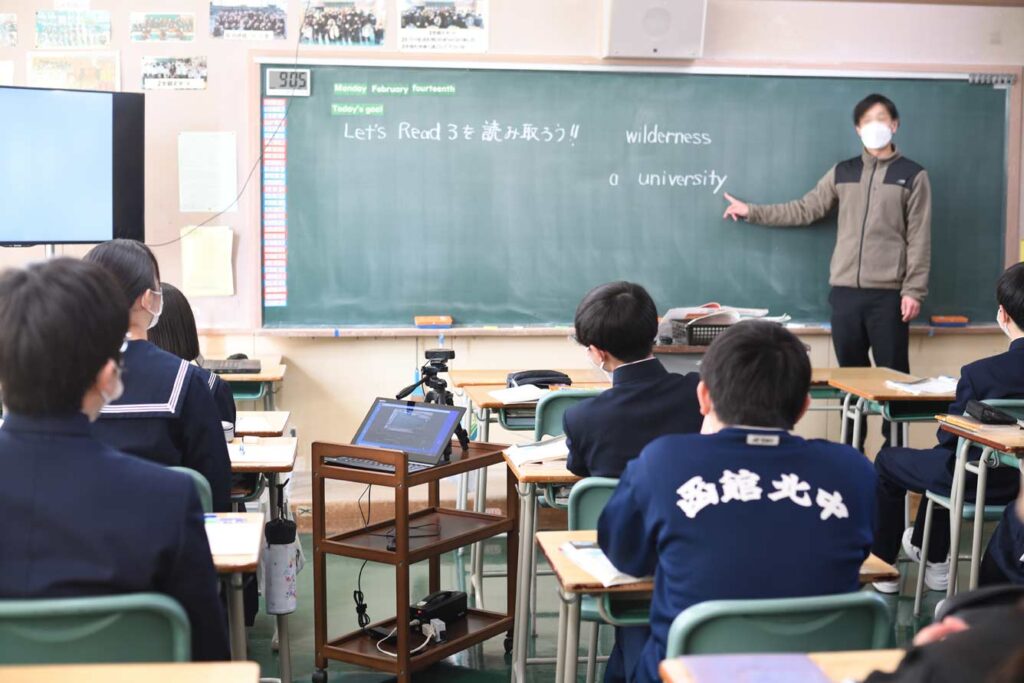
As a result, the camera angle perfectly captured the blackboard and the screen at the front of the classroom, and the high-quality microphone of the webcam allowed us to record the teacher’s voice at a very audible volume. We compiled these devices onto a wooden wagon, and put a portable power source on it so that it can be easily used in the classroom without worrying about wiring. This allowed us to complete a so-called “wagon camera” capable of recording a full day’s worth of lessons.The composition of the “Wagon Camera” is as follows:
- Notebook PC (NEC VersaPro PC-VP-KB41)
- Web Camera (Logicool C922n, approximately 7,000 yen)
- Mini Tripod (Velbon Ex-mini, approximately 3,000 yen)
- Video Recording Software (OBS Studio 27.2.4, free)
- Portable Power Source (about 240Wh, approximately 25,000 yen)
- Wooden Wagon (approximately 4,000 yen)
2. Operation of the “Wagon Camera”
In order to make the text on the blackboard or display used in the class viewable and readable for students at home, we tested various options and found that the balance of HD (1280×720) video quality was good.
This quality was set in OBS and the classes were recorded on the microSD card of the notebook PC. The recorded video becomes a file of 600-800 megabytes for a 50-minute lesson. Therefore, to reduce the operation time for file transfer, we decided to remove the microSD card from the notebook PC and transfer it to the computer for uploading.
We started testing the “Wagon Camera” in February and thought that one wagon per grade would suffice, because the content of subject lessons does not change much within the same grade.
However, upon actual operation, we discovered various issues, such as differences in the subjects taught on a given day depending on the classroom, and discrepancies in progress. Also, in grades where multiple subject teachers are assigned, there were issues such as having lessons taught by teachers who the students are not usually taught by.
Therefore, when we began full-scale operation in April, we prepared a dedicated “Wagon Camera” for each class to improve the system so that students who are absent can watch the lessons of their own class from that day.The operation procedure of the “Wagon Camera” is as follows:
- In the event that a student becomes a close contact of a new coronavirus case or contracts the virus and is suspended from attending school, we will confirm with the guardian and the student themselves whether they wish to have on-demand delivery of lessons.
- In the morning, before the school activities begin, move the Wagon Camera to the classroom where the student in question belongs, launch OBS, and prepare to record the lessons.
- When recording the classes, ask for cooperation from students who are seated near the Wagon Camera. Have them help with tasks such as pressing the button to start recording, pointing the camera towards the blackboard or display where the teacher is explaining, etc., to record the lessons.
- After school, the responsible teacher collects the microSD card and portable power source from the classroom, deletes unnecessary portions from the video, uploads it to Google Classroom, and starts the streaming.
As for the device used to watch the streaming, we either delivered the one-device-per-person equipment provided by the school to their homes, or had the students use their own home PC or smartphone.
3 Utilizing Google Classroom
The recorded lessons are uploaded as “Materials” on Google Classroom (hereafter referred to as Classroom). Students who are absent in each class watch the classes from there.
The advantages of using Classroom as a platform for streaming are as follows:
- In Hakodate’s public elementary and middle schools, Classroom has been introduced at the time of the implementation of the one-device-per-person policy, and the students are accustomed to its operation.
- For teachers as well, the user interface is easy to understand, and operations like uploading are straightforward.
- From among the students in the class, it is possible to selectively stream the lessons to those who are absent.
- Supplementary materials such as handouts can also be distributed along with in the form of pdf files, allowing for questions and comments.
- It provides features to prevent the downloading of class videos, making it safer to use compared to platforms like YouTube (Select the class video uploaded to the class drive folder and restrict downloads during student viewing from “Share settings”, which makes downloading impossible).
- A large amount of storage space is available for storing the recorded class videos as review materials or for handling non-attendant students. (In our case, we used about 380 gigabytes as of the end of August).
As such, initiatives to deliver classes through “full recording” to students who were unable to attend school due to the coronavirus-related suspension began in April. We created a topic titled “Learning Support for Absences” within the Class section of Classroom, which was set up for each grade and class, and posted the recorded materials on a daily basis.
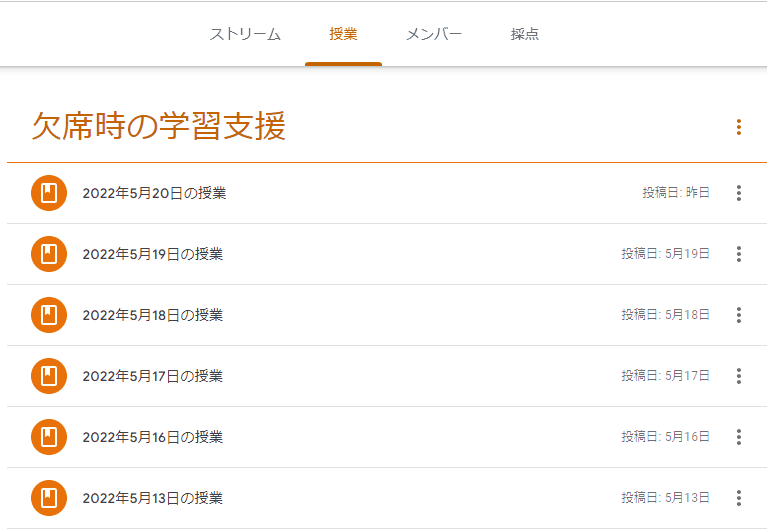
Students who were suspended from attending school log in to their own Classroom from home, select the materials for the dates they were absent, and choose and watch the lessons from the list of recorded classes.

Subjects such as physical education and art, which involve practical and active work, are inevitably difficult to record and often go unrecorded. However, the number of lessons delivered between April and the end of August through our initiatives was 535.
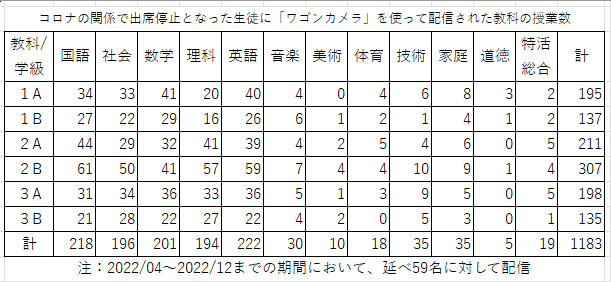
The lessons recorded with the “wagon camera” had clear image quality and audio, and the explanations using blackboards or displays were vivid, providing an atmosphere close to actually being in the classroom.
(Above: a screenshot of a lesson using a display, below: a screenshot of a lesson using a blackboard)
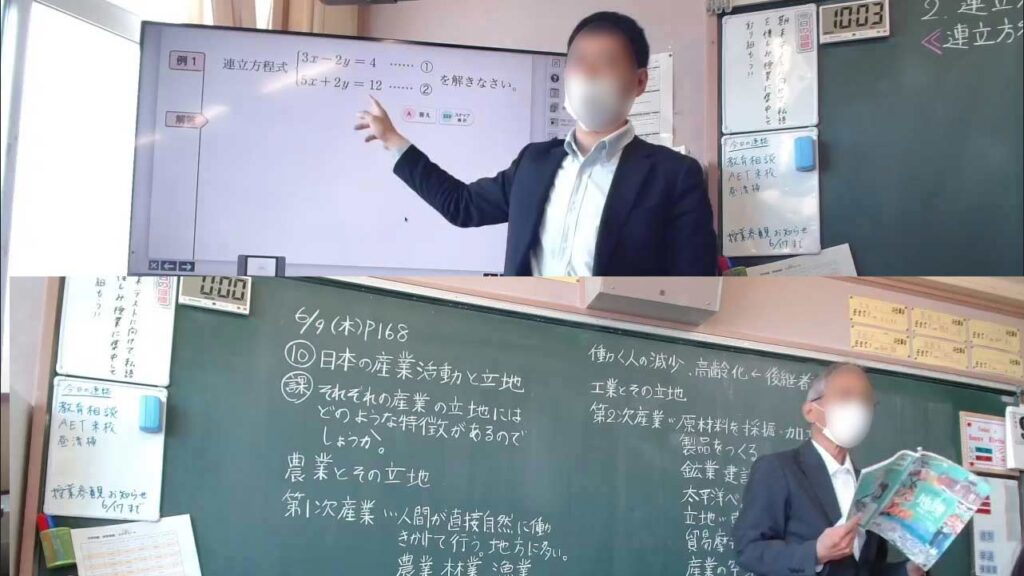
As we continued to operate, we started to convert the handouts distributed in class into .pdf format and post them along with the class videos. The homeroom teachers started inserting messages they wrote on the blackboard in the morning before the first class to communicate with the absent students. When they entered a problem-solving exercise, they would signal the camera to stop recording. These operational innovations were gradually accumulated.
In addition, the students also utilized this system in new ways. After a lecture in the classroom, the ‘wagon’ was moved to the science room to record an experiment. The idea of moving from the classroom to the necessary location was not initially considered in the operation, but over time, the operation evolved to include moving as needed to record lessons.
4 “Wagon Camera” filled with a heart that cherishes each and every student
Practices using ICT are often carried out by teachers who are specialized in that field in their own subjects or classes. However, our school was able to implement it across the entire school. The following points were behind the success of such efforts by all the school staff and entire school.
- The attitude of cherishing each and every student and being close to the children has permeated all staff members.
- From 2020, we have been actively engaging in delivering lessons and providing learning support using ICT, and the awareness of utilizing ICT among teachers has increased.
- The emotions that students have towards their teachers and school are positive, and the expectations from parents towards the school are also forward-looking, creating an atmosphere that encourages such initiatives.
- There is strong trust in the management team that prepares equipment and environments while managing the limited school budget, involving staff members, and moving forward with an eye to the next challenges.
No matter what kind of teacher, there is always some hesitation to recording their lessons and presenting them in this way. This is true for staff at our school as well.
However, as the coronavirus began to rage from January, and it came to be expected in February that long-term suspensions of attendance for 5 to 10 days would occur frequently if nothing changed, the school understood clearly what had to be done. The goal became: “Let’s somehow deliver classes to students who cannot attend school for an extended period of time due to becoming close contacts or infected with COVID-19.”
In the short period until the start of the new term, trial and error was repeated, equipment that could be prepared within the limited school budget was sought, and ways to operate without overburdening the staff were explored.
The solution reached was the “Wagon Camera”. This initiative is packed full of the feelings of all the Hakodate Kita Junior High School staff who cherish each and every student.
5 Towards Improvement
In early September, we conducted a survey to understand how students and parents perceive this initiative. We received responses from 62%, or 126 out of 202 households.
First, 73% of the parents responded that they were aware of our school’s initiative to the question of whether they knew about it. Next, when asked if their child had actually used this initiative, 20% of them responded that they had. Even among households that had never used it before, 91% are considering doing so in the future. This initiative has gained high support among students and parents.
Next, when asked about the positive aspects of using this system, the most common response was “being able to keep up with studies”, followed by “being able to study according to their own health conditions”. Among the nine parents who responded that they would not use the wagon camera, seven said that it was difficult to study when their health was poor. This highlights the importance of considering the health of students, not only in the use of the “Wagon Camera”, but also in learning support using web conferencing systems.
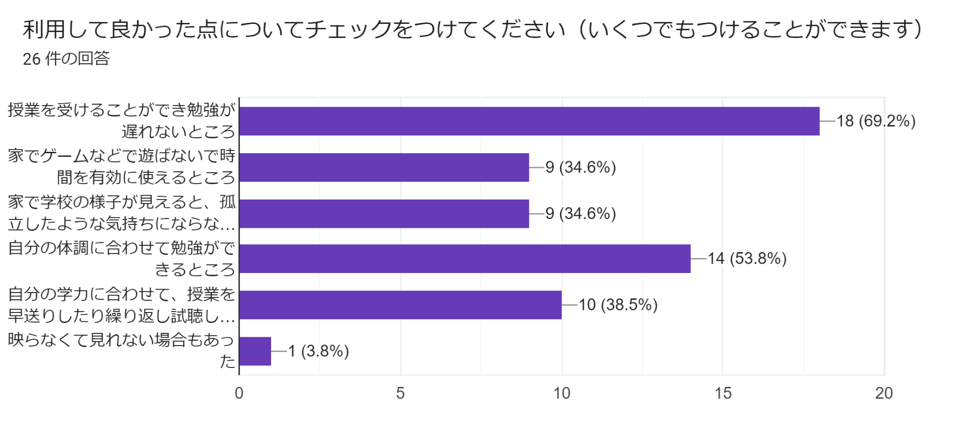
In addition, the survey revealed high demand for improvements regarding the fact that “class handouts are not handed out at the same time as the video viewing”, and “there are times when it is not possible to watch the class within the day due to the functions of the Classroom (due to video compression)”.
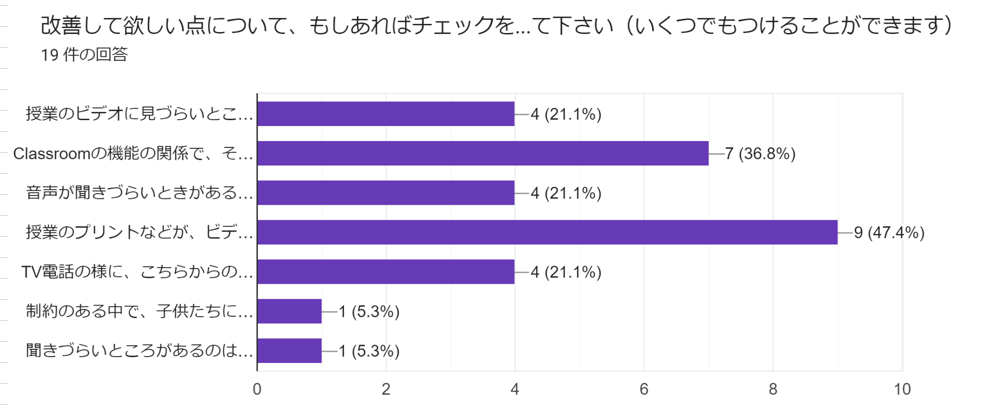
Although we had made improvements since June by attaching handouts in pdf format, it was insufficient. Going forward, we will introduce an environment where we can directly write into the pdf and improve the convenience of handouts.
As for making it possible to listen to the day’s lessons within the same day, we are considering making improvements using the live broadcasting feature available on OBS that allows simultaneous recording and broadcasting.
Feedback from students who actually watched at home, such as “Not only the learning content, but also the atmosphere of the class was conveyed, which made me pleased,” gave us courage.
Later on, there was a request saying, “I couldn’t participate during the discussion, so I wanted to participate,” so moving forward, we would like to develop this “Wagon Camera” initiative further, incorporating a web-conferencing system in situations where exchange among students is needed.
Furthermore, in the free writing section by parents, there were requests to use it as a resource for children not attending school or for revision purposes. We are positively considering further utilization of the recorded lessons.
6 Conclusion
We have kept going with the single-minded drive to help and support our struggling students. I questioned whether we could really provide all lessons, whether we could keep it up, and whether it would be accepted by the students and their parents.
Looking back, our daily efforts consisted of constant trial and error.
Today, I would like to share the joy of reaching this point with the staff and express my deepest gratitude to the students and their parents.
Former Principal of Hakodate Kita Junior High School, Toshiyuki Okuzaki.
Note: This essay received a special selection award in the school research category of the educational research paper competition sponsored by the Hokkaido Education Public Employees Association in the 2022 fiscal year.
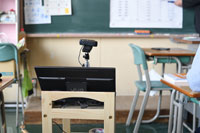
コメントを残す